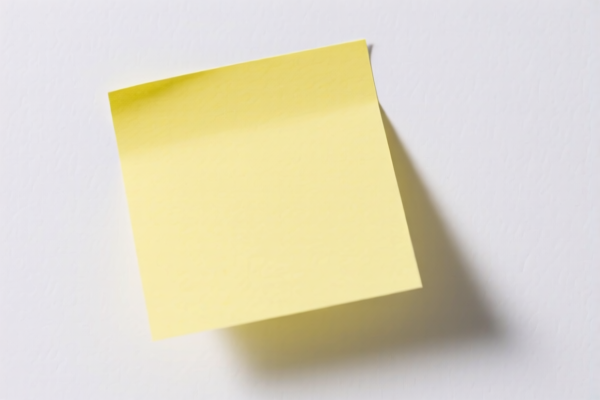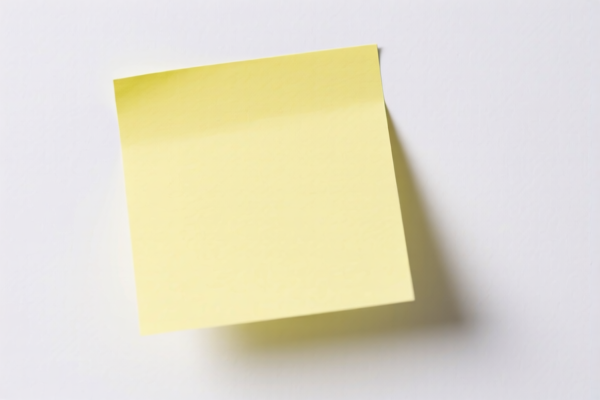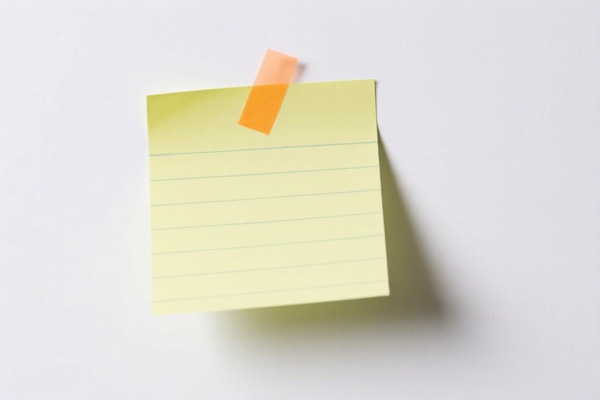| HS Code | Official Doc | Tariff Rate | Origin | Destination | Effective Date |
|---|---|---|---|---|---|
| 4823901000 | Doc | 55.0% | CN | US | 2025-05-12 |
| 4821102000 | Doc | 55.0% | CN | US | 2025-05-12 |
| 4821104000 | Doc | 55.0% | CN | US | 2025-05-12 |
| 3215905000 | Doc | 56.8% | CN | US | 2025-05-12 |
| 3215901000 | Doc | 58.1% | CN | US | 2025-05-12 |
| 3214905000 | Doc | 58.25% | CN | US | 2025-05-12 |
| 3214901000 | Doc | 55.0% | CN | US | 2025-05-12 |
| 3919905060 | Doc | 60.8% | CN | US | 2025-05-12 |
| 3919901000 | Doc | 61.5% | CN | US | 2025-05-12 |
| 3921904010 | Doc | 34.2% | CN | US | 2025-05-12 |
| 3921904090 | Doc | 34.2% | CN | US | 2025-05-12 |




Post-it Note
A Post-it Note is a small, typically square-shaped piece of paper with a light adhesive on one side, designed for temporary attachment to surfaces.
Material:
- Paper: Typically manufactured from lightweight, often brightly colored, paper. Recycled content is common.
- Adhesive: A repositionable adhesive is crucial. Originally, 3M developed a low-tack, pressure-sensitive adhesive that allowed notes to be attached and reattached without damaging the surface or leaving residue. The adhesive is generally an acrylic-based polymer.
Purpose:
- Temporary reminders: The primary function is to provide quick, easily visible reminders.
- Note-taking: Used for brief notes, brainstorming ideas, and capturing thoughts.
- Organization: Employed for marking pages, categorizing items, and creating visual cues.
- Communication: Can be used to leave messages for others.
Function:
The key function lies in the balance between adhesion and removability. The adhesive allows the note to stick to most surfaces, but also allows it to be easily peeled off without tearing the paper or leaving a sticky residue. This is achieved through microspheres in the adhesive, which reduce the contact area and allow for easy repositioning.
Usage Scenarios:
- Office environments: Used on computer monitors, desks, calendars, and documents.
- Home use: Attached to refrigerators, mirrors, walls, and other household surfaces for reminders, shopping lists, and messages.
- Education: Students use them for marking textbooks, creating study notes, and brainstorming.
- Brainstorming sessions: Facilitate idea generation and organization through visual mapping.
- Project management: Used in agile methodologies (e.g., Kanban boards) to track tasks and progress.
Common Types:
- Standard Size (3x3 inches): The most common size, suitable for general reminders and notes.
- Super Sticky Notes: Utilize a stronger adhesive for surfaces where standard notes may not adhere well.
- Large Size Notes: Available in larger formats for more extensive notes or visual displays.
- Colored Notes: Available in a wide range of colors for categorization, highlighting, or aesthetic purposes.
- Pop-up Notes: Dispense in a cascading manner for easy access.
- Flag Highlighters: Translucent notes used to mark pages in books or documents.
- Shaped Notes: Available in various shapes (arrows, hearts, etc.) for decorative or specific purposes.
- Digital Post-it Notes: Software applications and services that replicate the functionality of physical Post-it Notes in a digital environment.
Post-it notes are typically composed of paper and adhesive. Based on this composition and common use, the following HS codes may be relevant:
- 4821102000: Paper and paperboard labels of all kinds, whether or not printed: Printed: Printed in whole or in part by a lithographic process. This code applies if the post-it notes are printed using a lithographic process. Chapter 48 covers paper and paperboard; Heading 4821 specifically covers labels.
- 4821104000: Paper and paperboard labels of all kinds, whether or not printed: Printed: Other. This code applies if the post-it notes are printed using a method other than lithography. Chapter 48 covers paper and paperboard; Heading 4821 specifically covers labels.
- 3919905060: Self-adhesive plates, sheets, film, foil, tape, strip and other flat shapes, of plastics, whether or not in rolls: Other: Other Other. This code may apply if the adhesive backing is plastic-based. Chapter 39 covers plastics; Heading 3919 covers self-adhesive plates, sheets, film, foil, tape, strip and other flat shapes.
- 4823901000: Other paper, paperboard, cellulose wadding and webs of cellulose fibers, cut to size or shape; other articles of paper pulp, paper, paperboard, cellulose wadding or webs of cellulose fibers: Other: Of paper pulp. This code applies to post-it notes made of paper pulp and cut to size or shape. Chapter 48 covers paper and paperboard; Heading 4823 covers other articles of paper pulp, paper, paperboard, cellulose wadding or webs of cellulose fibers.
Regarding HS code 3919905060, please note that the material composition of the adhesive backing is important for classification. If the adhesive backing is plastic-based, this code may be applicable.
The total tax rate for codes 4821102000, 4821104000, and 4823901000 is 55.0%. The total tax rate for code 3919905060 is 60.8%.
Customer Reviews
No reviews yet.